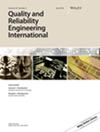利用威布尔分布冲击模型对串联可靠性系统进行统计推断
IF 2.8
3区 工程技术
Q3 ENGINEERING, INDUSTRIAL
引用次数: 0
摘要
在本研究中,我们利用一个具有致命冲击源的冲击模型,定义了一个具有非独立和非相同成分的系列系统。在这里,我们假设冲击是随机和独立发生的,遵循具有不同规模和形状参数的 Weibull 分布。在此过程中会产生一个参数未知的可依赖性模型。对模型参数做出统计结论是本研究的主要目的。我们采用最大似然法和贝叶斯法来确定模型参数的点估计和区间估计。我们将证明,要获得参数的最大似然估计值,无需求解似然方程的解析解。因此,我们将使用 R 程序来逼近参数的点估计和区间估计。此外,我们还将使用 bootstrap-t 和 bootstrap-p 方法来逼近置信区间。关于贝叶斯方法,我们假定每个模型参数都是独立的,并遵循一个伽马先验分布,其附带的超参数值范围也是独立的。模型参数的后验分布没有实际形式。因此,我们无法以封闭形式得出贝叶斯估计值。为了解决这个问题,我们使用了基于马尔科夫链蒙特卡罗方法的 Metropolis-Hasting 算法中的 Gibbs 采样器来压缩后验分布。为了证明这项研究的相关性,我们详细介绍了一个真实数据集的应用。本文章由计算机程序翻译,如有差异,请以英文原文为准。
Statistical inference of a series reliability system using shock models with Weibull distribution
In this study, we define a series system with non‐independent and non‐identical components using a shock model with sources of fatal shocks. Here, it is assumed that the shocks happen randomly and independently, following a Weibull distribution with various scale and shape parameters. A dependability model with unknown parameters is produced by this process. Making statistical conclusions about the model parameters is the main objective of this research. We apply the maximum likelihood and Bayes approaches to determine the model parameters' point and interval estimates. We shall demonstrate that no analytical solutions to the likelihood equations must be solved to obtain the parameters' maximum likelihood estimates. As a result, we will use the R program to approximate the parameter point and interval estimates. Additionally, we will use the bootstrap‐t and bootstrap‐p methods to approximate the confidence intervals. About the Bayesian approach, we presume that each model parameter is independent and follows a gamma prior distribution with a range of attached hyperparameter values. The model parameters' posterior distribution does not take a practical form. We are unable to derive the Bayes estimates in closed forms as a result. To solve this issue, we use the Gibbs sampler from the Metropolis‐Hasting algorithm based on the Markov chain Monte Carlo method to condense the posterior distribution. To demonstrate the relevance of this research, a real data set application is detailed.
求助全文
通过发布文献求助,成功后即可免费获取论文全文。
去求助
来源期刊
CiteScore
4.90
自引率
21.70%
发文量
181
审稿时长
6 months
期刊介绍:
Quality and Reliability Engineering International is a journal devoted to practical engineering aspects of quality and reliability. A refereed technical journal published eight times per year, it covers the development and practical application of existing theoretical methods, research and industrial practices. Articles in the journal will be concerned with case studies, tutorial-type reviews and also with applications of new or well-known theory to the solution of actual quality and reliability problems in engineering.
Papers describing the use of mathematical and statistical tools to solve real life industrial problems are encouraged, provided that the emphasis is placed on practical applications and demonstrated case studies.
The scope of the journal is intended to include components, physics of failure, equipment and systems from the fields of electronic, electrical, mechanical and systems engineering. The areas of communications, aerospace, automotive, railways, shipboard equipment, control engineering and consumer products are all covered by the journal.
Quality and reliability of hardware as well as software are covered. Papers on software engineering and its impact on product quality and reliability are encouraged. The journal will also cover the management of quality and reliability in the engineering industry.
Special issues on a variety of key topics are published every year and contribute to the enhancement of Quality and Reliability Engineering International as a major reference in its field.

 求助内容:
求助内容: 应助结果提醒方式:
应助结果提醒方式:


